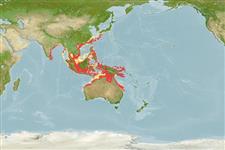(كوسه ها و سپرماهيان) (sharks and rays) >
Orectolobiformes (Carpet sharks) >
Hemiscylliidae (Bamboo sharks)
Etymology: Chiloscyllium: cheilos (Gr.), lip, referring to membranous and broad lower lip, presumably of C. plagiosum (proposed without a species); skylion, Greek for dogfish or small shark (See ETYFish); punctatum: Latin for spotted, referring to scattering of small blackish spots on young specimens (See ETYFish).
More on authors: Müller & Henle.
Environment: milieu / climate zone / depth range / distribution range
بوم شناسي
دريايي وابسته به آب سنگ; تغييرات عمق 0 - 85 m (Ref. 43278). Tropical; 34°N - 26°S, 78°E - 155°E
Indo-West Pacific: Andaman Island and India east to Philippines, north to Japan and south to Australia.
Length at first maturity / Size / Weight / سن
Maturity: Lm ?, range 87 - ? cm
Max length : 132 cm TL جنس نر / بدون خواص جنسي; (Ref. 106604)
خارهاي باله پشتي (کل) : 0; خارهاي باله مخرجي: 0. Genus: Nostrils subterminal on snout; pre-oral snout long, mouth closer to eyes than snout tip; eyes and supraorbital ridges hardly elevated; no black hood on head or large spot or spots on sides of body above pectoral fins (Ref. 43278). Caudal fin with a pronounced subterminal notch but without a ventral lobe (Ref. 13575).
Species: Young with dark transverse bands and usually a scattering of a few dark spots, bars not prominently edged with black (Ref. 13575, 43278). Adults light-brown, usually without a color pattern (Ref. 13575). Dorsal fins larger than pelvic fins, with projecting free rear tips (Ref. 13575). Body without lateral dermal ridge (Ref. 4832,43278, 13575).
A common inshore bottom shark found on coral reefs, often in tide pools (Ref. 247). Probably feeds on bottom invertebrates and small fish (Ref. 6871). Oviparous (Ref. 50449). Can survive up to 12 hours out of water (Ref. 247). Gills sometimes infested by larval isopods (Praniza-larva of isopod Gnathia) (Ref. 247). Utilized as food (Ref. 247); for its meat and fins. Caught frequently by demersal gillnet, longline and trawl fisheries operating in insular and continental shelf waters (Ref.58048).
Life cycle and mating behavior
بلوغ | تولید مثل | تخم ریزی | تخم ها | Fecundity | توزاد ( لارو)
Oviparous, with rounded egg cases (Ref. 247). Paired eggs are laid. Embryos feed solely on yolk (Ref. 50449).
Compagno, L.J.V., 1984. FAO Species Catalogue. Vol. 4. Sharks of the world. An annotated and illustrated catalogue of shark species known to date. Part 1 - Hexanchiformes to Lamniformes. FAO Fish. Synop. 125(4/1):1-249. Rome, FAO. (Ref. 247)
وضعيت در فهرست قرمز IUCN (Ref. 130435: Version 2024-2)
خطر برای انسان ها
Harmless
استفاده انسانی
ماهي گيري – شيلات: تجاري; آكواريوم: تجاري
ابزارها
گزارش های ويژه
بارگيری XML
منابع اينترنتي
Estimates based on models
Preferred temperature (Ref.
123201): 24.6 - 29.1, mean 28.2 °C (based on 1554 cells).
Phylogenetic diversity index (Ref.
82804): PD
50 = 0.5039 [Uniqueness, from 0.5 = low to 2.0 = high].
Bayesian length-weight: a=0.00398 (0.00176 - 0.00901), b=3.09 (2.89 - 3.29), in cm total length, based on LWR estimates for this (Sub)family-body shape (Ref.
93245).
Trophic level (Ref.
69278): 4.1 ±0.64 se; based on food items.
جهندگی (Ref.
120179): پايين ، كم, كمينه زمان لازم براي دو برابر شدن جمعيت 5/4 – 14 سال (Fec assumed to be <100).
Fishing Vulnerability (Ref.
59153): Very high vulnerability (79 of 100).
Nutrients (Ref.
124155): Calcium = 9.48 [1.89, 37.88] mg/100g; Iron = 0.322 [0.077, 0.926] mg/100g; Protein = 19.3 [17.2, 21.5] %; Omega3 = 0.0808 [, ] g/100g; Selenium = 33.3 [10.3, 98.8] μg/100g; VitaminA = 56.4 [16.8, 193.3] μg/100g; Zinc = 0.864 [0.413, 1.781] mg/100g (wet weight);
